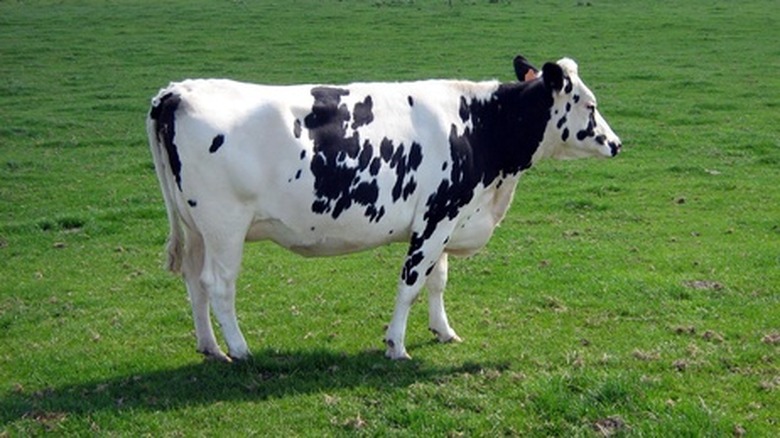Skeletal System Of A Cow
The skeletal system is one of nine systems that make up an animal body, according to the Food and Agriculture Organization of the United Nations (FAO). Anyone working on a dairy farm, beef farm or any farm that includes caring for cattle needs to understand the skeletal makeup of a cow. However, even if an agriculturalist doesn't plan on working with cows, any student completing an agricultural degree will also most likely need to learn the skeletal system of a cow before graduating.
Significance
Significance
The skeletal system within any living creature is the framework upon which the body is built, according to FAO. It consists of the bones and the muscles in the body, including the joints that connect the bones, the ligaments that allow the joints to move and the cartilage that cushions the bones. The skeletal system carries the weight and support of the body while it functions to support bone structure, shape, development and function, and to move the body. By understanding the makeup of a cow's skeletal system, cow owners, farmers and agricultural specialists can provide their cattle with the correct diet, exercise and living conditions that will provide the healthiest skeletal makeup.
Skeletal Diagram
Skeletal Diagram
In the front of the cow, from the front legs to the head, a diagram of the cow's skeletal system includes the cannon, knee joint, radius, sternum, elbow joint, ulna, humerus, shoulder joint, shoulder blade and eye socket. From the top of the head and along the top side of the cow, the skeletal system includes the horn cones, cervical vertebrae, dorsal vertebrae, lumber vertebrae, sacrum and hip bone. Along the back side of the cow, points of interest on the cow's skeletal system include:
- the femur
- knee joint
- tibia
- hock joint
- ribs
- pasterns
- coronary
These are the major components of the cow's skeletal system that are expected to be learned by cow owners and agricultural students.
Nutritional Disorders
Nutritional Disorders
Numerous diseases and conditions can occur within a cow's skeletal system if the cow's immune system is weak or if the cow is malnourished. Milk fever is one condition that affects cows when calcium leaves the bloodstream to support milk production faster than calcium is put back into the bloodstream through eating. The result is a muscular and skeletal breakdown, resulting in the cow being weak and unable to stand. Ketosis is another disorder that affects female cows in early lactation. By drawing body fat to help meet the energy needs of milk production, central nervous systems can become dysfunctional, causing cows to stumble, lose their appetite and become weak.
Hereditary Conditions
Hereditary Conditions
Other conditions that affect the cow's skeletal system are hereditary. Spinal muscular atrophy (SMA) and spinal dysmielination (SDM) are both genetic disorders that affect the skeletal makeup of newborn calves. In SMA, severe muscular atrophy causes weakness of the rear legs, which can eventually lead to the calves being unable to stand at all. Death can occur after two to four weeks from respiratory failures. IN SDM, calves often cannot rise from a lying position and die within the first week of life. Spastic paresis is a genetic disorder that affects adult cows, causing a hind leg to remain raised and extended backward, and spastic syndrome causes cramping and sporadic spasms of different skeletal muscles. If these conditions are spotted early, physical therapy or dietary supplements can help prevent further damage to the skeletal system or death.
Mineral Supplements
Mineral Supplements
Cattle require numerous minerals and dietary supplements to keep their skeletal systems healthy and to prevent the conditions listed above, according to the University of Missouri Extension. These minerals allow for normal bodily maintenance, growth and reproduction. The major minerals needed in large doses for cows include:
- calcium
- phosphorus
- magnesium
- potassium
- sodium
- chlorine
- sulfur
Minerals needed in much smaller doses include:
- iron
- zinc
- manganese
- copper
- iodine
- cobalt
- selenium
Each mineral has its own purpose. For example, calcium is needed to form and maintain healthy bones, teeth and muscle tissue, much like in human bodies. Potassium is needed to promote good appetite and decrease the chance of stiffness in the joints.
Cite This Article
MLA
Howe, Alicia. "Skeletal System Of A Cow" sciencing.com, https://www.sciencing.com/skeletal-system-cow-6711201/. 24 April 2017.
APA
Howe, Alicia. (2017, April 24). Skeletal System Of A Cow. sciencing.com. Retrieved from https://www.sciencing.com/skeletal-system-cow-6711201/
Chicago
Howe, Alicia. Skeletal System Of A Cow last modified March 24, 2022. https://www.sciencing.com/skeletal-system-cow-6711201/
